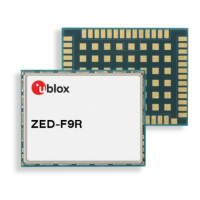ZED-F9R-Integration manual
it into backup mode; this can be set up with UBX-RXM-PMREQ. Leave open if unused, this function
is disabled by default.
3.7.7 WT and DIR inputs
ZED-F9R pin 22 (WT) is available as a wheel tick input. Pin 23 (DIR) is available as a direction input
(forward/reverse indication).
By default the wheel tick count is derived from the rising edges of the WT input.
The WT input may be configured to use both the rising and falling edges of the wheel tick signal. To
use both edges, the wheel tick pulses shall have approximately 1:1 mark:space ratio regardless of
speed. The minimum recommended pulse width is 10 us.
For optimal performance the wheel tick resolution should be less than 5 cm. With the maximum
supported wheel tick resolution is 40 cm.
The wheel tick input shall change frequency linearly with respect to the change in vehicle speed.
When the vehicle is stationary, there shall be no wheel tick pulses at the WT input. This is especially
important at system shutdown and startup.
Performance may be affected if there are wheel ticks on the WT pin while the vehicle is
stationary.
The DIR input shall indicate whether the vehicle is moving forwards or backwards.
By default, the DIR pin polarity is automatically initialized once the vehicle has reached the required
minimum speed (see Accelerated initialization and calibration procedure section). The DIR pin
polarity can also be configured with the CFG-SFODO-DIR_PINPOL key.
Incorrect operation may occur if WT input is used without a matching DIR input.
Alternatively, the vehicle WT (or speed) and DIR inputs can be provided via one of the communication
interfaces with UBX-ESF-MEAS messages. In this use case, the WT pin can be configured as EXTINT
to provide a time mark for the UBX-ESF-MEAS messages. The DIR pin can be left open.
Do not exceed the maximum voltage of 3.6 V at the WT and DIR inputs.
For more information, see the interface description [2].
3.7.8 GEOFENCE_STAT interface
The ZED-F9R provides a GEOFENCE_STAT pin that indicates the current geofence status as to
whether the receiver is inside any of the active areas.
This feature can be used for example to wake up a sleeping host when a defined geofence condition
is reached. It is possible to configure up to four circular areas as geofence locations. Once configured,
the receiver continuously compares its current position with the preset geofenced areas.
For more information in this functionality, see Geofence state evaluation.
The receiver toggles the assigned pin according to the combined geofence state.
There are three possible outcomes for each geofence:
•
Inside - The position is inside the geofence with the configured confidence level
•
Outside - The position lies outside of the geofence with the configured confidence level
•
Unknown - There is no valid position solution or the position uncertainty does not allow for
unambiguous state evaluation
UBX-20039643 - R06
3 Receiver functionality Page 58 of 119
C1-Public

